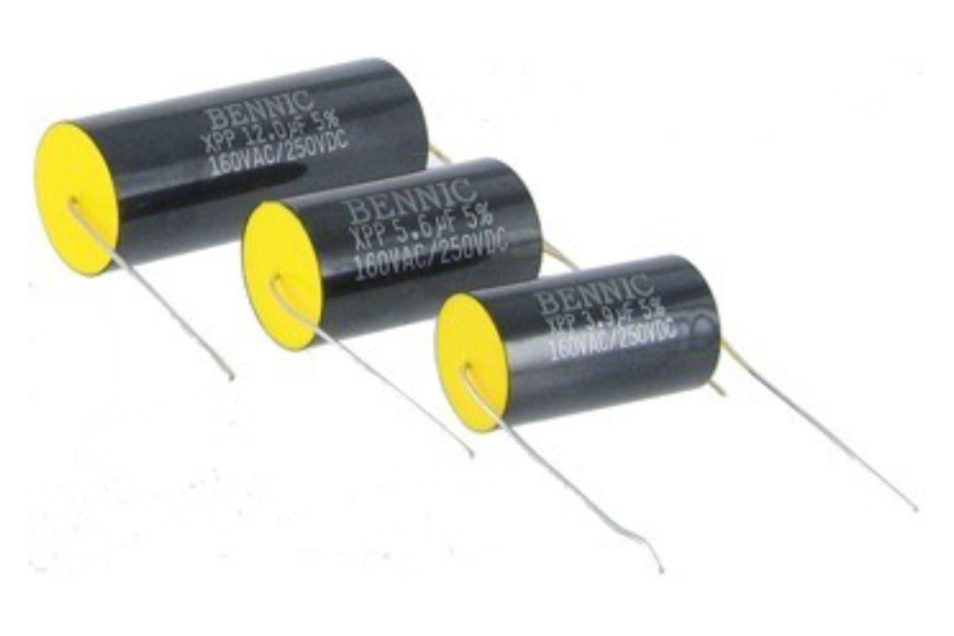Tech Talk
Loudspeaker Crossover Film Capacitors: A Look Inside
By George Short
Senior Principle Acoustic Engineer

Capacitors are one of the three key elements in a loudspeaker passive crossover network (the others being the inductor and resistor). The function of a capacitor is to pass high frequencies and attenuate low frequencies. In almost all passive crossovers, at least one capacitor can be found in series with the tweeter.
A capacitor operates by storing potential energy in the form of an electric field, in a dielectric material between two conductive layers. Originally (around 1900) this was just two layers of foil (one anode or +, and one cathode or -) held apart by a layer of waxed paper dielectric, but as the science evolved someone came up with the idea of adding another dielectric layer, then rolling the assembly into a cylinder.
In time the waxed paper was replaced with polymer film, becoming film-and-foil capacitor. Even though every aspect of performance and manufacturability has greatly improved, the construction concept remains entirely unchanged to this day:

The foil layer in a film-foil capacitor is the thinnest that can be produced economically, generally 0.0002 inch thick (called “triple O-2 foil”, or 0.2mil), although for unusually high current requirements a thicker foil can be used.
The film thickness is typically 0.00004”, so about one-fifth as thick as the foil. The benefit of making capacitors this way is that the current carrying capability is extremely high, as it is actual foil through which the electrons flow. The performance disadvantage is that in the event there is a flaw in the film, or if it spot-melts during use, the void shorts one foil to the other, the capacitor becomes a straight wire, and something downstream blows up. Also, because of the amount of material involved and the manufacturing complexity of precision winding four layers of material, film-and-foil capacitors are large, heavy and expensive.


Metallized film capacitors, developed between 1940’s and 1970’s, replace the foil with aluminum atoms vapor-deposited directly onto a film - the same process employed to make shiny mylar balloons. Typically the aluminum layer is 0.000002”, so one-one-hundredth the thickness of the equivalent foil, and wound with the film is a volumetric saving of almost 80%.
But because the metallization layers are so thin, they have a higher electrical resistance (called ESR) than foil, so they cannot conduct much electrical current without heating up (the exact same process that heats up the convection coils inside a toaster). Metallized caps always exhibit higher resistive losses than film-and-foil equivalents. One way to improve this situation is the Multi-cap method developed by Chris Hagen, described in TechTalk from January 2022 (https://www.harmanluxuryaudionews.com/2022/01/).
Beyond their small size, another essential benefit to this construction is that the metallization layer is so thin, in the event there is a fault in the film that allows one aluminum layer to touch the next, the resulting spark vaporizes all of the nearby aluminum and the capacitor immediately heals itself(!), and goes back to working just fine. Metallized film capacitors are legendary for their long term durability and stability, and are widely used in high performance crossover networks (including ours).
In a perfect world, that is all anyone would every need to know about metallized film capacitors….

Digging Deeper
….of course, it’s not quite a perfect world, so in practice at every stage of the manufacturing process all sorts of things can go awry:
The winding process:
Metallization is not the same as foil, and on a microscopic level the metallization looks like a film plateau covered in tiny aluminum mountains. The electrical connection between mountains is made by this same aluminum, a random process with some good connections, some bad, and some mountains not connected at all; it is not continuous like a homogeneous foil. So ultimately, the metallized aluminum layer relies on these imperfect connections to conduct electricity, and therefore exhibits even higher resistivity than a theoretically equivalent thickness foil.
Then, as the metallized films are wound into a capacitor by spinning them co-radially around a cylindrical core, the films are held under tension by the winding machine. Tension stretches the film, and this process tears some of the connections between the aluminum mountains. So once again, the effective series resistance increases.
And in between each film winding layer, a layer of air sneaks in. Air is bad because increases the distance between the layers of cathode and anode, making the capacitor less efficient, and it also allows room for vibration inside the capacitor body.
What to do?
Well, in the old days, capacitor manufacturers would just increase the film winding tension, winding the capacitor tighter so the air layer is smaller, and some manufacturers still rely on this method. This is good for minimizing the air layer, but bad for the metallization layer.
Modern capacitor winding machines jump through all sorts of hoops to precisely adjust and maintain the winding tension at the absolute optimum, then employ pressure rods riding the capacitor body as it is grows, squeezing out the air. These machines also automatically finish the capacitor body in a protective tape wrap:


Adding the connection wires
The next step is to connect all of the concentric windings on one end together. Here, the empty volume extended under the protective wrap acts as a cave, and the manufacturer sprays a zinc-tin alloy cement into this cave to make the connections (called the schoopage). Simple, but another random process. In the early days this spray was kind of chunky, and relied on impact to make the electrical connection. Over time the end spray got better. The most modern systems use either a technique called “arc spraying”, where the capacitor end is electrically polarized and the cement spray – now a fine metallic mist- is pulled in between the windings as it solidifies; or “plasma spraying”, where the mist is heated and self-welds the capacitor conductive ends. At right is a schoopage plasma sprayer.

After all this, a time-test, regular old tin-plated copper wire is soldered to the cement, and the capacitor is operational.
The last step, done by hand, is to fill the end caves with epoxy, securing the wires and seal the capacitor from outside air and moisture.

Does the film material matter?
A highly controversial topic for another day.
A JBL crossover:

Here at HARMAN Luxury Audio we make extensive use of top quality film capacitors, and other excellent components, in our passive crossover networks.

